Upcoming Events:
Error 406 - Not Acceptable
Generally a 406 error is caused because a request has been blocked by Mod Security. If you believe that your request has been blocked by mistake please contact the web site owner.
Full event list
Error 406 - Not Acceptable
Generally a 406 error is caused because a request has been blocked by Mod Security. If you believe that your request has been blocked by mistake please contact the web site owner.
FIRST® Robotics Competition (FRC®)
Control System 2009-2014
Control System Hardware Components
National Instruments is the manufacturer and donator of the Compact RIO (cRIO) hardware/firmware that forms the backbone of the FIRST Robotics Competition control system beginning in 2009.The control system/electronics consist of:
- National Instruments cRIO
- The FRC controllers run VxWorks 6.3
- FIRST is limited to three (3) specific types of cRIO modules for Digital I/O, Analog input, and Solenoid outputs
- FIRST custom Power Distribution Panel
- Three types of cRIO module breakout boards-Digital, Analog, Solenoid
- A specific make & model of 12v battery (17Ah)
- Two specific models of speed controllers to control up to 40A continuous variable speed motors
- A specific type of relay to control up to 20A motors, pneumatic solenoids, and custom electronics
- Pneumatic solenoids
- A specific WiFi bridge/AP
- User selectable Win7 netbook/laptop to command the robot by custom controls or up to four USB joysticks/game controllers (must run the FIRST Driver Station application)
Shortcuts
- Control System Components:
cRIO FRC II | cRIO FRC I | Digital Sidecar | Analog Breakout | Solenoid Breakout | Power Distribution Panel | Jaguar | Victor | Talon | Spike | HiTec Servo | Driver Station-2012 | Driver Station-2011 | Driver Station-2010 | Joysticks | Cypress I/O | WiFi-2013 | RSL | Main Breaker | Breakers | Battery |
- Sensors:
Camera | Camera Gimbal | Rotary Encoder | Photosensor | Gyro | Accelerometer | Rotary magnetic encoder | Potentometer | Linear Encoder | Pressure Switch | Limit Switch | Sonar |
- Outdated But Usable at Home:
WiFi-2009 | Driver Station-2009 |
cRIO FRC IIBriefing on new cRIO In 2012 a new version of the cRIO is introduced, the cRIO FRC II. On introductory sale to veteran teams in the Fall of 2011, a bare chassis will cost ~$300, while the chassis with three modules (Analog, Digital, and Solenoid) will cost ~$550. 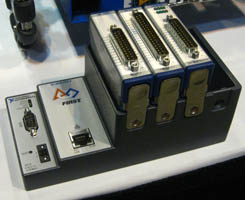
Based on the NI cRIO-9076, this smaller, lighter model has only 4-slots, one each for analog/digital/solenoid modules, plus an additional slot that will be hardcoded for a second module of FIRST's choice. The cRIO FRC II has twice as much memory and RAM as the original FRC cRIO, with a newer Freescale 5125 processor running at 400MHz, but with a bigger cache and higher memory bandwidth. In comparison, it will probably appear to otherwise deliver similar performance as the original FRC cRIO. The mounting holes through the base are smaller than the original. It will continue to run even if the voltage drops as low as 9v. It's still intended to be powered through the protected regulation of the 24v Power Distribution Panel source in competition, but can be powered by something else for bench testing. FRC Live @ Championship Holding down the reset button long enough will reboot the cRIO into safe mode. Other settings that used to be done by DIP switches are set through software. Screw-terminal wiring - use 24 to 12 AWG copper conductor wire with 0.39 in. of insulation stripped from the end. Specs.

cRIO source: National Instruments cRIO ordering info. |
cRIO FRC I(2009-2011) legal for use in 2012 as wellBriefing on original cRIO The original FRC cRIO consists of a metal chassis with integrated controller and 8 slots for plug-in modules-(2) analog input modules, (2) digital I/O modules, (2) solenoid modules. By FRC rules there must be an analog module in slot 1 to provide robot battery voltage feedback, and a Digital module in slot 4 for the robot status light. Additional modules are optional, but all modules must go in these specific positions if they are used at all (slot 1 is closest to the cRIO panel of lights, DIP switches, Ethernet and serial connectors, and 24v power connector):
NI recommends mounting this on it's side to better protect the modules and breakouts and so condensation doesn't pool on the circuit board behind the module connectors.
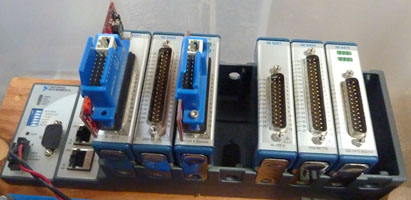
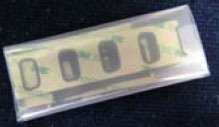 How to Clean the cRIO-FRC and Install Gaskets.pdf These gaskets to keep metal dust and shavings out of the cRIO innards came in some KOPs or they can be purchased through AndyMark. |
cRIO Breakout BoardsSource: AndyMark Wago connectors source: AndyMark |
Digital SidecarThis breakout board is connected to the cRIO Digital I/O Module (NI 9403) via a long cable. 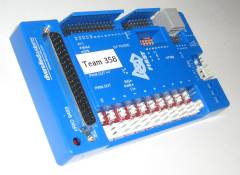
2010 improvements (can be identified by the red PCB) added reverse voltage protection Digital Sidecar Description Digital Sidecar specs Source: AndyMark DB37 ribbon cable source: AndyMark (a regular DB37 cable is also available) |
Analog BreakoutThis breakout board is connected directly to the cRIO Analog Input Module (NI 9201) , or extended with a ribbon cable and placed in a more protected spot. 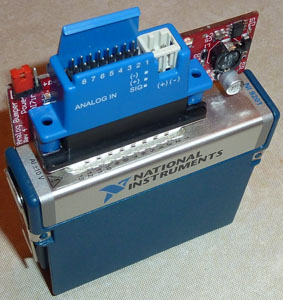
There is a 2009 (red PCB) and a 2010 (blue PCB) version of this board with slightly different characteristics.
2010 improvements (can be identified by the red PCB):
Analog Breakout Description Analog Breakout Specs Source: AndyMark |
Solenoid BreakoutThis breakout board is connected directly to the cRIO Solenoid Module (NI 9472) , or extended with a ribbon cable and placed in a more protected spot. It is similar in appearance to the Analog Breakout above. 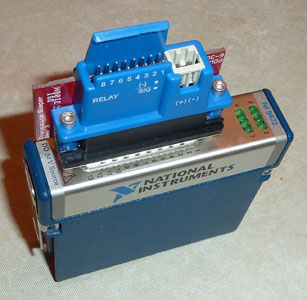
Solenoid Breakout Description Solenoid Breakout specs Source: AndyMark |
Power Distribution Panel (PD)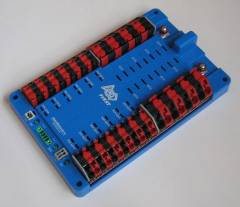
2010 improvements (can be identified by the red PCB):
Power Distribution Panel specs Power Distribution Panel circuit design Source: AndyMark |
Speed Controller-Jaguar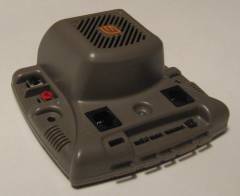
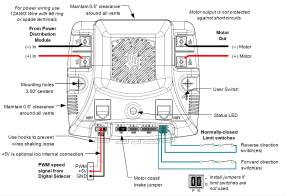
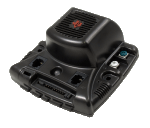
One Page Intro., Jaguar Getting Started document This Jaguar H-bridge speed controller from Texas Instruments (formerly Luminary Micro) comes in two types that can be told apart by their covers: grey/tan or black. The original 2009 release was gray/tan and had a few issues with static electricity, as well as back EMF from the motor that caused their destruction. The replacement in 2010 was black and redesigned using Texas Instruments components (after TI acquired the company that made the Jags - Luminary Micro). There are some minor electrical differences, but the major difference is the grey has two CAN connectors for daisy chaining, but the black has one RS232 and one CAN to act as a communications bridge between the cRIO and a chain of Jaguars. Details 2011 CAN Getting Started.pdf
cRIO Jaguar PWM specs (and test measurements using a run-of-the-mill digital voltmeter):
The Jaguar provides smoother control and is especially valuable at fine-tuned low speed control and it self-protects against over-current/temp. The Victor can handle some higher current stress for longer periods of time, but in a severe over-current case it would fail catastrophically. There are also reports of the Jaguar not working well with the Denso window motors. In any case new applications should be throughly tested to see which speed controller is more appropriate. Fault ConditionsA slow flashing Red LED indicates that the MDL-BDC detected one of the following fault conditions:
When a fault condition occurs, the motor shuts down and the LED indicates a fault state during the fault condition and for 3 seconds after the fault cause is cleared (except for the limit switch fault, which is cleared instantly). A slow flashing Yellow LED indicates that the MDL-BDC is not receiving a valid control signal. CALIBRATION PROCEDURETo calibrate the servo-style PWM input for a specific range, connect a PWM source, then:
The MDL-BDC samples these signals and centers the speed range and neutral position between these limits. A calibration failure will be signaled if an out-of-range signal is detected. To reset the servo-style PWM input to the default factory range:
Source: Digikey usually has a special FRC price during the season (~$85) or AndyMark |
Speed Controller-VictorVictor 884 Users Manual ( This has been around longer than the Jaguar and has different characteristics. Both speed controllers can be used. The Victor allows high current for longer than the Jaguar, while the Jaguar permits finer control. The Jaguar also does not seem to work well with the Window motors under certain circumstances, causing the Window motors to heat up unusually and be shutdown by the Window motor's thermal overload protection. 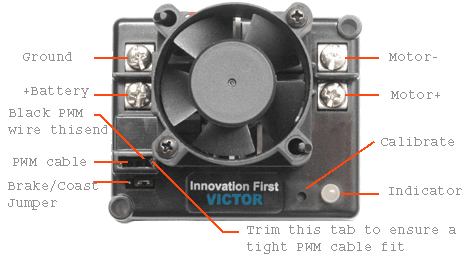
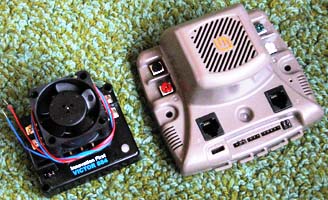
cRIO victor PWM specs (and test measurements using a run-of-the-mill digital voltmeter):
Source: VexPro (usually offers a special discount to FRC teams during the season) |
Speed Controller-TalonBrushed DC motor speed control featuring a sealed design with passive cooling and a footprint slightly smaller than a Victor. Without the optional fan it is also much shorter. From Cross the road electronics 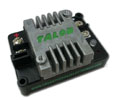
Source: AndyMark Cross the road electronics |
Spike Relay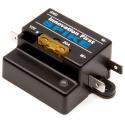 The Spike is not a PWM device although it is controlled by a PWM-style cable. It can not be connected to an R/C hobby type receiver. The Spike
is designed to plug into special Relay Ports.
The Spike is not a PWM device although it is controlled by a PWM-style cable. It can not be connected to an R/C hobby type receiver. The Spike
is designed to plug into special Relay Ports.
Source: VexPro |
HiTec Servo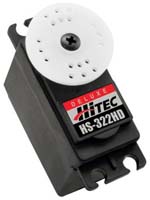
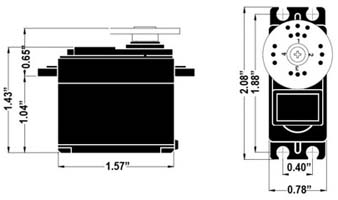
The HiTec servo is a small motor that can be commanded to rotate to a particular position in a range of ~270 degrees. It has a varied of "horns" or the white part in the accompanying photo that are interchangeable, and are often used with homegrown mechanical linkages to increase their effectiveness. This attaches to the Digital Sidecar PWM outputs, BUT also requires the use of a jumper beside the PWM output, because it runs on the 6v power from the PWM connection, 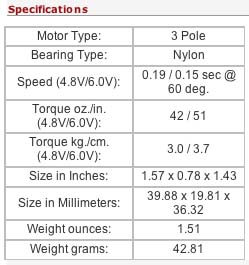
Source: AndyMark |
Driver Station (DS) (2012/2013/2014 version)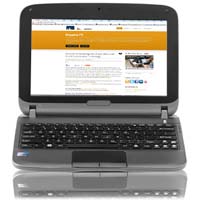 Any laptop is now legal with only the Driver station application a requirement.
Any laptop is now legal with only the Driver station application a requirement.
Rookies are still provided with a newer model Classmate (E12). FIRST provides new (optional) Classmate images to update older Classmates to Windows 7 (if necessary) and pre-install the current year's programming environment(s). Especially important with the oldest E09 because the very limited disk space does not leave enough room to perform the normal installation process. The 2012 Classmate power adaptor produces 2.1 amps @ 19v with center positive on the barrel connector. 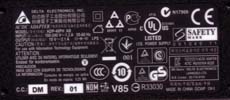
Classmate E12 Specs |
Driver Station (DS) (2011 version)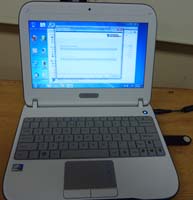 Any laptop is now legal with only the Driver station application a requirement.
Any laptop is now legal with only the Driver station application a requirement.
Come cautions: Run the Driver Station application as administrator, so it can adjust network settings. Triple check that your IP settings are exactly what is required by the playing field:
Turn off firewalls and anti-virus, because they can block or otherwise interfere with field network traffic. Keep your laptop charged at ALL times. Many failures are due to a lack of laptop battery power - USB ports brown-out, laptops slow down or sleep to conserve power or shutdown altogether while a match is in progress. Laptop USB is notorious for cutting power to USB ports while the laptop is on battery or after hibernating/sleeping.
The 2011/2012/2013 Classmate power adaptor produces 2.1 amps @ 19v with center positive on the barrel connector. 
Classmate E10 Specs |
Driver Station (DS) (2010 version)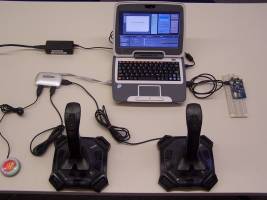 In 2010 FRC introduced a small netbook laptop as the Driver Station. This netbook continued to be used in subsequent years.
In 2010 FRC introduced a small netbook laptop as the Driver Station. This netbook continued to be used in subsequent years.
As with new technology applications everywhere unexpected problems arose when 1,808 Classmates went into competition.
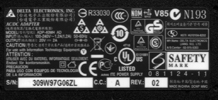
Classmate spare parts Classmate E09 Manual |
Joysticks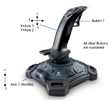
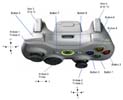
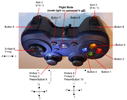
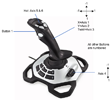
Logitech Attack 3, xBox 360, Logitech F310-Flight Mode or Sports Mode Extreme 3D Pro (click on game controllers for FRC mapping of buttons & axes) To control the robot the Kit of Parts includes a pair of the classic Attack3 Joysticks. Any USB wired game controller can be used, such as Xbox 360 or Playstation 3 compatible game controllers. It just has to be recognizable by the Windows OS with an appropriate hardware driver on the Driver Station laptop as a game controller. Non-game controllers such as keypads are not recognized by the Driver station application. Note: Some game controllers have mode buttons and switches that change how the buttons and axes are mapped. This can inadvertently lead to a mysterious loss of control if the driver hits the button/switch accidentally. Controllers without such a switch are more foolproof to use. Warning: power hungry controllers may brown out during competition. Basic controllers connected directly to the laptop USB ports are safest. When the driver station laptop battery gets low it begins to cut power to USB ports starting with the ports with the highest power drain. Usually, that means starting with ports connected to bigger drain USB hubs that have several devices hanging off them. Changing Windows USB Power Settings Source: Game console retailers like Best Buy, GameStop, Target, Walmart |
Texas Instruments Stellaris Launchpad Evaluation Kit LM4F120 (2014)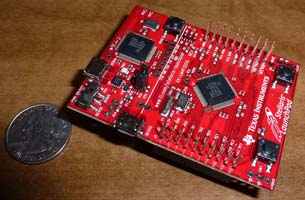
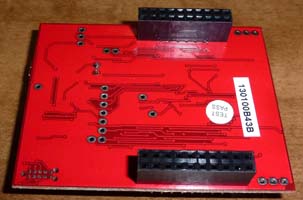
The Stellaris requires custom firmware provided by TI to set it up to behave like a standard HID joystick (or two joysticks), making buttons and dials available for user custom designed control board extensions. The unit is stackable with other breakout boards to add capability or simplify screw terminal connections. The Stellaris is powered by and communicates through a USB connection to the laptop/netbook running the Driver Station application. User Manual Source: Digikey |
First Touch DS I/O Breakout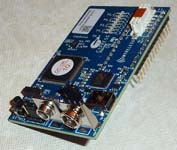
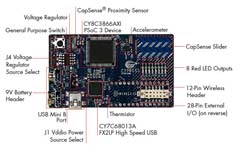
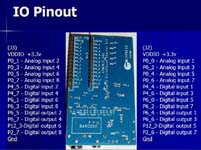
The Cypress First Touch requires special FRC-specific firmware to be used with and recognized by the Driver Station. NOTE: there have been three versions of the Cypress board released over the years. There are two FRC Cypress firmware versions that match changes in the board FRC_IO.2009.v3.hex & FRC_IO.2012.v3.hex come with the FRC river Station Update and after installation is located on your PC at: C:\Users\Public\Documents\FRC\ Boards manufactured between 2009-2011 use the 2009 version of the firmware, later boards use the 2012 version. If you are unsure you can just try each and the PSoC software will simply tell you if the firmware doesn't match the board. If you see Cypress FirstTouch firmware update error: ERROR!---> | The hex file was built for silicon revision ES3, but the acquired device is revision ** then PSoC version 3.17 must be used to apply new firmware. The Cypress board is powered by and communicates through a USB connection to the laptop/netbook running the Driver Station application. The 9v battery is not used in our application. How_To_Configure_Your_I-O_Module.pdf Source: Special Mount (an enclosure is also for sale) |
Wireless2013 VersionIn 2013 the D-Link DAP-1522 Rev B AP/bridge is used. It replaces the previously used Rev A.
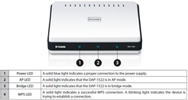

12v-5v Power Converter_CLL.pdf WARNING: This is a 5 volt device and requires the use of a 12v-to-5v power converter for use on the robot. Source: DAP-1522 Rev B Source: Voltage Regulator (12v to 5v) D-Link DAP-1522 Rev B manual (2012) D-Link DAP-1522 Rev B Firmware for FRC (2012) |
2011 VersionIn 2011 the D-Link DAP-1522 Ap/bridge is used.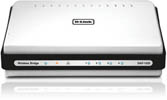
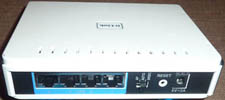
How to Configure Your DAP-1522 Robot Radio (2011) D-Link DAP-1522 Rev A manual (2011) D-Link DAP-1522 Rev A Firmware 1.21 for FRC (2011) |
Rockwell Robot Status Light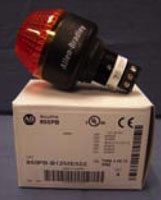
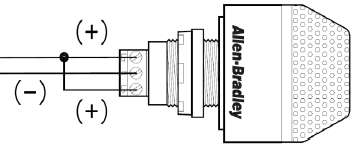

Wired one way it will flash forever, but wired correctly it will repeat exactly what the RSL LED on the Digital Sidecar does. Ground, Power and most importantly-a jumper MUST be used. RSL Wiring ( The RSL blink pattern tells what state the robot is in. The patterns can be changed year-to-year but in 2011 they were:
|
Main Breaker/Robot Power Switch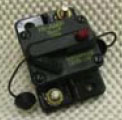
The battery connects through Anderson connectors to this 120 amp breaker used as the main robot power switch. It is very unlikely that this will ever trip under normal conditions as it withstands amperage much greater than 120a for some period of time before tripping. If it does trip you have a serious electrical problem, or ill designed overloaded power draws.
120amp Main Breaker/Robot Power Switch Spec. Source: AndyMark |
Snap Action Breakers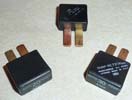
These mount in the Power Distribution Panel and are self-resetting 40/30/20 amp breakers for individual circuit protection. It's important to remember that these only safeguard the wiring, and it's critical that they each be used with the properly rated wire gauge (or better). They do not protect devices like the speed controllers. Snap-Action 30/20a Breaker Spec. Snap-Action 40a Breaker Spec. Source: VexPro or AndyMark |
EnerSys NP18-12 or MK ES17-12 Batteries FRC robots are restricted to a specific 12v battery. One or two batteries are provided in the Kit and if they are the same past years batteries can be used as spares.
It's a good idea to have several (4-5) batteries (and chargers) for competition.
FRC robots are restricted to a specific 12v battery. One or two batteries are provided in the Kit and if they are the same past years batteries can be used as spares.
It's a good idea to have several (4-5) batteries (and chargers) for competition.
Specs: EnerSys NP18-12 Datasheet MK ES17-12 Datasheet Source: AndyMark |
SensorsFRC 2011 Sensor Manual |
Axis 206/M1011 Webcam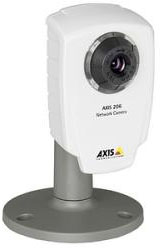 This optional network camera is connected either to the cRIO via port 2 (the 206 requires a crossover Ethernet cable to work, the M1011 does not), or to the DLink network bridge (any cable/camera model). For the default camera code to work with it there must be a special user account - username: FRC/password: FRC
This optional network camera is connected either to the cRIO via port 2 (the 206 requires a crossover Ethernet cable to work, the M1011 does not), or to the DLink network bridge (any cable/camera model). For the default camera code to work with it there must be a special user account - username: FRC/password: FRC
Note: the screw mount on the camera back takes an M4 metric nut. 
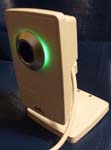

Camera Image Compression vs. image file size
Source: AndyMark |
Camera Gimbal (aka, Pan & Tilt Assembly)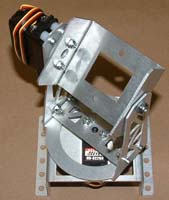
This comes in the KOP with the camera and can also be purchased through AndyMark Camera Pan and Tilt Assembly Diagrams |
KOP US Digital Encoders
The KOP encoders are 360 CPR (Counts Per Revolution), with 4X quadrature decoding, you get 1440 positions per revolution. Which gives you a unique position every 1/4 degree. 10,000 maximum RPM for these encoders. This encoder can be used directly with a Jaguar speed controller if you are using the alternate CAN bus. For use directly by your cRIO code this connects to several of the Digital Sidecar digital inputs:
US Digital site, YouTube Assembly Guide US Digital Encoder EP4 Assembly Instructions ( US Digital Encoder Datasheet ( Source: AndyMark |
Photosensor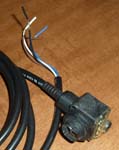
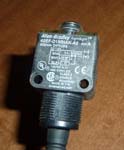
FRC Photoswitch Installation This is an Allen-Bradley RightSight, model 42EF-D1MNAK-A2. There is an adjustment screw on the top that increases/decreases the sensitivity, but be careful not to over-turn it or it will break and it's not fixable. In the 2011 rules had an exception for wiring the power for this particular sensor. It does not work below 11v, so the normal Power Distribution supply would not work as soon as the robot moved and the voltage dipped. The power for this was allowed to be taken from the Solenoid Breakout in turn wired to the 24v regulated port on the Power Distribution Panel. The signal wire still connects to a Digital Sidecar digital input. This avoids power dips even as the battery voltage drops.
Allen-Bradley RightSight Specs ( Source: AndyMark |
Kit GyroscopeAnalog Devices ADW22307 1-axis Analog Gyroscope 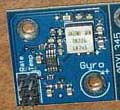
Wire to analog input:
The gyro positive direct is shown on the board. The second triplet of pins returns temperature (not commonly used). FRC Gyroscope Specs |
Kit AccelerometerAnalog Devices ADXL345 3-axis Digital Accelerometer. 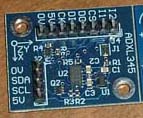
Maximum of 250 degrees per second for the Analog Devices ADW22307. Nominal output is 2.5V at standstill, plus 7mV/¡/s. This connects to the Digital Sidecar digital inputs. SPI output (J4): wire to Digital I/O pins on the Digital Sidecar
The alternate I2C output (J2): wire to the pins on the Digital Sidecar found directly behind the NXT connector. By default, the I2C address is 0x3A. The address can be changed to 0xA6 by shorting J1 with a blob of solder.
FRC Accelerometer Specs |
Rotary Magnetic Encoderaustriamicrosystems AS5030 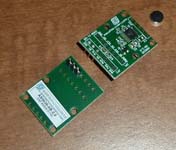
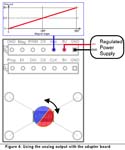
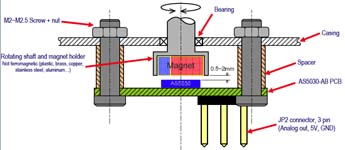
Measures absolute angle (8 bits over 360 degrees) and angular rate (up to 30,000 RPM). There are six ways possible to receive input from this device. See the FRC 2011_Sensor_Manual.pdf for the wiring of other input methods. Here's one method that connects to the Analog Breakout (Filtered PWM):
NOTE: There is a 4.8 Hz filter on this output, so it is only useable for very low bandwidth (slowly moving) angular position measurements and is not appropriate in angular rate applications. This output can be sampled at 10Hz. FRC Magnetic Rotary Encoder User Manual |
Linear Encoder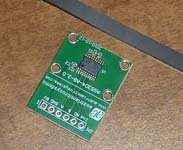

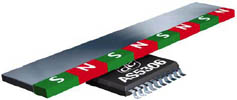
This connects as a quadrature encoder to a Digital sidecar digital input:
FRC Magnetic Linear Encoder User Manual |
Pneumatic Pressure Sensor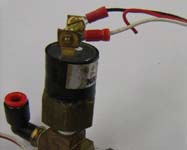
The pressure switch sensor is used as part of the pneumatic sub-system. It tells the controller when to turn the compressor on as the air pressure drops, and when to turn it off as pressure reaches maximum. It connects to a Digital Sidecar digital input. The terminals are interchangable.
Spec: Nason Pressure Switch |
Potentometer
Potentiometers (or "pots") in robotics are most frequently coupled to a mechanism to measure the angle of rotation or a distance of mechanism travel. It is a simple analog device that's a little noisy, so doesn't return an exact value and has a certain amount of flicker in it's readings. Think of a volume control knob (avoid "audio tapers" for robotics use though) or a light dimmer. Pots come in several useful varieties:
They have three terminals:
The voltage divider (used when connected as a cRIO Analog input) uses all three terminals. The variable resistor only requires the ground and signal terminals. Source: Radio Shack (search for "potentiometer") |
Limit Switch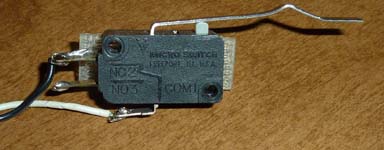
Limit switches are intended to be pressed by some mechanical mechanism to signal a stop or limit of movement. The switch connects to a Digital Sidecar digital input and is marked on the side with a simple wiring diagram.
Normally Open is how most people typically think of switches operating. There are two wiring options. The switch only requires two connections:
FRC Limit Switch Spec Source: Radio Shack (search for "SPDT switch") |
Maxbotix - LV-MaxSonar-EZ1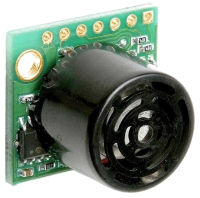
Connects to the Analog Breakout and returns an analog voltage output scaling (Volts/512=inches) A 5v power supply yields ~9.8mV/inch LV-MaxSonar-EZ1 Datasheet Source: Maxbotix |
Outdated But Still of Use at Home
Wireless2009 & 2010 VersionsThe 2009 & 2010 robot bridge used for Wi-Fi depended on the KOP supplied Linksys WGA600N, however that product is no longer made. An authorized replacement was the WET610N, but that was slow to link up and caused field delays.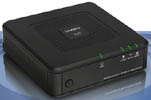
Linksys WGA600N wireless bridge manual (2009-2010) Linksys WET610N wireless bridge manual (2010 substitute) |
Driver Station (DS) (2009 only)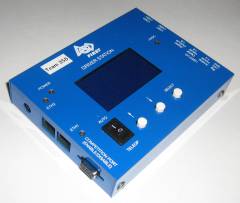
Mounting is possible by velcro, double-sided tape, or brackets to three of the cover screws (not the fourth screw protected by warranty tape).
Some button sequences:
 The 2009 Driver Station came with a ready-made disable/enable switch to plug into the Competition port. By default the DS is Disabled if this switch is not connected.
You can make your own by connecting pins 8 & 9 to a switch.
The competition port enable/disable switch included sticks out 2 1/8" in all from the case.
The 2009 Driver Station came with a ready-made disable/enable switch to plug into the Competition port. By default the DS is Disabled if this switch is not connected.
You can make your own by connecting pins 8 & 9 to a switch.
The competition port enable/disable switch included sticks out 2 1/8" in all from the case.
|
Get Microsoft Excel Viewer
Get Microsoft PowerPoint Viewer
Get WinZip

